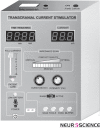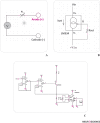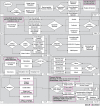Methodological dimensions of transcranial brain stimulation with the electrical current in human
- PMID: 25337348
- PMCID: PMC4202570
Methodological dimensions of transcranial brain stimulation with the electrical current in human
Abstract
Transcranial current stimulation (TCS) is a neuromodulation method in which the patient is exposed to a mild electric current (direct or alternating) at 1-2 mA, resulting in an increase or a decrease in the brain excitability. This modification in neural activities can be used as a method for functional human brain mapping with causal inferences. This method might also facilitate the treatments of many neuropsychiatric disorders based on its inexpensive, simple, safe, noninvasive, painless, semi-focal excitatory and inhibitory effects. Given this, a comparison amongst different brain stimulation modalities has been made to determine the potential advantages of the TCS method. In addition, considerable methodological details on using TCS in basic and clinical neuroscience studies in human subjects have been introduced. Technical characteristics of TCS devices and their related accessories with regard to safety concerns have also been well articulated. Finally, some TCS application opportunities have been emphasized, including its potential use in the near future.
Keywords: Non Invasive Brain Stimulation (NIBS); Transcranial Alternating Current Stimulation (tACS); Transcranial Direct Current Stimulation (tDCS); Transcranial Electrical Stimulation (tES).
Figures









Similar articles
-
Transcranial current stimulation in epilepsy: A systematic review of the fundamental and clinical aspects.Front Neurosci. 2022 Aug 25;16:909421. doi: 10.3389/fnins.2022.909421. eCollection 2022. Front Neurosci. 2022. PMID: 36090277 Free PMC article.
-
Basic and functional effects of transcranial Electrical Stimulation (tES)-An introduction.Neurosci Biobehav Rev. 2018 Feb;85:81-92. doi: 10.1016/j.neubiorev.2017.06.015. Epub 2017 Jul 6. Neurosci Biobehav Rev. 2018. PMID: 28688701 Review.
-
Comparison of Three Non-Invasive Transcranial Electrical Stimulation Methods for Increasing Cortical Excitability.Front Hum Neurosci. 2016 Dec 27;10:668. doi: 10.3389/fnhum.2016.00668. eCollection 2016. Front Hum Neurosci. 2016. PMID: 28082887 Free PMC article.
-
Optimization of multifocal transcranial current stimulation for weighted cortical pattern targeting from realistic modeling of electric fields.Neuroimage. 2014 Apr 1;89:216-25. doi: 10.1016/j.neuroimage.2013.12.002. Epub 2013 Dec 15. Neuroimage. 2014. PMID: 24345389 Free PMC article.
-
Rigor and reproducibility in research with transcranial electrical stimulation: An NIMH-sponsored workshop.Brain Stimul. 2018 May-Jun;11(3):465-480. doi: 10.1016/j.brs.2017.12.008. Epub 2017 Dec 29. Brain Stimul. 2018. PMID: 29398575 Free PMC article. Review.
Cited by
-
Neurobiological After-Effects of Low Intensity Transcranial Electric Stimulation of the Human Nervous System: From Basic Mechanisms to Metaplasticity.Front Neurol. 2021 Feb 15;12:587771. doi: 10.3389/fneur.2021.587771. eCollection 2021. Front Neurol. 2021. PMID: 33658972 Free PMC article. Review.
-
Transcranial Direct Current Stimulation (tDCS): A Beginner's Guide for Design and Implementation.Front Neurosci. 2017 Nov 22;11:641. doi: 10.3389/fnins.2017.00641. eCollection 2017. Front Neurosci. 2017. PMID: 29213226 Free PMC article.
-
Transcranial Alternating Current Stimulation (tACS) for Major Depressive Disorder.Psychiatr Ann. 2022 Nov;52(11):456-460. doi: 10.3928/00485713-20221018-02. Epub 2022 Nov 1. Psychiatr Ann. 2022. PMID: 39866331 Free PMC article.
-
Modulation of Working Memory Using Transcranial Electrical Stimulation: A Direct Comparison Between TACS and TDCS.Front Neurosci. 2018 Oct 23;12:761. doi: 10.3389/fnins.2018.00761. eCollection 2018. Front Neurosci. 2018. PMID: 30405341 Free PMC article.
-
Reply to "Separating neuroethics from neurohype".Nat Biotechnol. 2019 Sep;37(9):991-992. doi: 10.1038/s41587-019-0226-8. Nat Biotechnol. 2019. PMID: 31399722 No abstract available.
References
-
- Antal, A., Kincses, T. Z., Nitsche, M. A., & Paulus, W. (2003). Manipulation of phosphene thresholds by transcranial direct current stimulation in man. Exp Brain Res, 150(3), 375–378 - PubMed
-
- Antal, A., Kriener, N., Lang, N., Boros, K., & Paulus, W.. Cathodal transcranial direct current stimulation of the visual cortex in the prophylactic treatment of migraine. Cephalalgia, 31(7), 820–828 - PubMed
-
- Antal, A., Nitsche, M. A., & Paulus, W. (2001). External modulation of visual perception in humans. Neuroreport, 12(16), 3553–3555 - PubMed
-
- Arfai, E., Theano, G., Montagu, J. D., & Robin, A. A. (1970). A controlled study of polarization in depression. Br J Psychiatry, 116(533), 433–434 - PubMed
-
- Arul-Anandam, A. P., & Loo, C. (2009). Transcranial direct current stimulation: a new tool for the treatment of depression? J Affect Disord, 117(3), 137–145 - PubMed
Publication types
LinkOut - more resources
Full Text Sources
